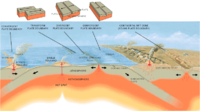
Photo from wikipedia
Although plate tectonics has pushed the frontiers of geosciences in the past 50 years, it has legitimate limitations, and among them we focus on both the absence of dynamics in… Click to show full abstract
Although plate tectonics has pushed the frontiers of geosciences in the past 50 years, it has legitimate limitations, and among them we focus on both the absence of dynamics in the theory and the difficulty of reconstructing tectonics when data are sparse. In this manuscript, we propose an anticipation experiment, proposing a singular outlook on plate tectonics in the digital era. We hypothesize that mantle convection models producing self‐consistently plate‐like behavior will capture the essence of the self‐organization of plate boundaries. Such models exist today in a preliminary fashion, and we use them here to build a database of mid‐ocean ridge and trench configurations. To extract knowledge from it, we develop a machine learning framework based on Generative Adversarial Networks (GANs) that learns the regularities of the self‐organization in order to fill gaps of observations when working on reconstructing a plate configuration. The user provides the distribution of known ridges and trenches, the location of the region where observations lack, and our digital architecture proposes a horizontal divergence map from which missing plate boundaries are extracted. Our framework is able to prolongate and interpolate plate boundaries within an unresolved region but fails to retrieve a plate boundary that would be completely contained inside of it. The attempt we make is certainly too early because geodynamic models need improvement and a larger amount of geodynamic model outputs, as independent as possible, is required. However, this work suggests applying such an approach to expand the capabilities of plate tectonics is within reach.
Journal Title: Tectonics
Year Published: 2019
Link to full text (if available)
Share on Social Media: Sign Up to like & get
recommendations!